Inuvik, NWT
Inuvik is a town of about 3,500, set at the edge of the Mackenzie River delta in the northwestern area of Northwest Territories, Canada. It’s not the farthest north – there are plenty of “outpost” towns where hardy Natives make a subsistent living. Rather, Inuvik is a “working” town and the intentional hub of the western Arctic for area commerce. Scattered along a mile-long stretch of highway and waterway, it’s hard to get an overview in this wetland terrain. The landscape up here is flatter than Kansas.

Buildings in the town are largely functional in nature. Not shabby, but not elegant. There is definitely the higher-class neighborhood, as with all towns, but “downtown” is pretty plain. There’s one traffic light, and it is permanently lit yellow in the main direction and blinking red on the cross street. A simple stop sign would have sufficed, but maybe someone thought the town needed more class?
Almost all the buildings in town are built up on pilings, with at least three feet clearance above the ground. This is to ensure that the permafrost is not melted by the heat of the occupied building. When permafrost (frozen water, dirt, and rocks) melts, it does so unevenly, and building foundations settle and crack.
That cell phone tower in the background serves the entire town. Interestingly enough, there is only sketchy cell service at the airport, a few miles south.
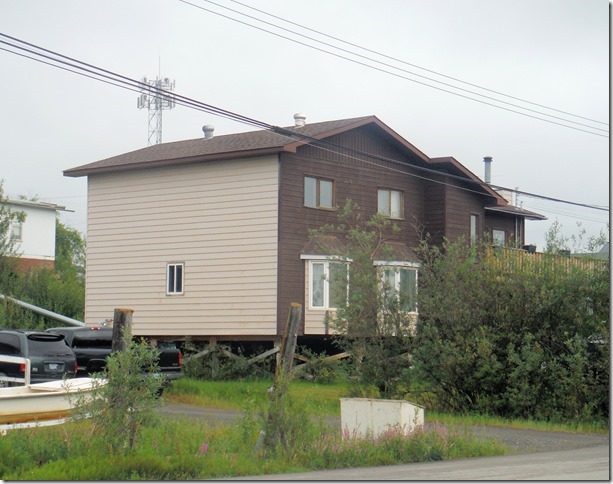
Speaking of the airport, it is much grander than the scope of the town would indicate. This is evidence of its “hub” status.
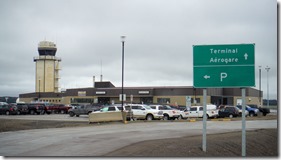
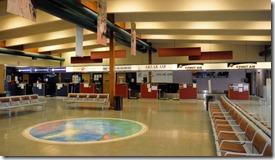
I sensed a curious contrast between the tall, imposing control tower at the airport and the older, weather-worn buildings that comprise the town. Kind of a 50,000 population tower adjacent to the 3,500 population town – it speaks again to all the outlying communities that it supports.
The Inuvik airport is also quite a contrast to other airports we have passed by – usually identifiable only by a faded tattered wind sock. In fact, two “airports” along the Dempster are actually wider, straight sections of the Dempster, and are flagged by red-orange cones as emergency airstrips.
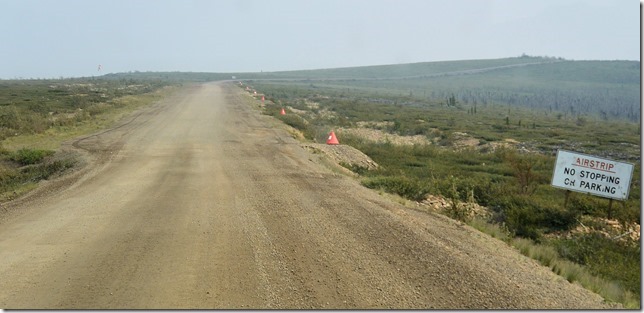
In Inuvik, there is some tourist-oriented activity, mostly having to do with local Native culture. [The formal term in Canada is “First Nations” for what might be called Indians, Eskimos, Inuits, or Native Americans in the U.S. Many of the locals we’ve talked to call themselves Indians, or Gwich’in, Tahltan or other tribal-specific names, so I will just use the term Native as a multi-country generic.]
Sports-wise, there is fishing in the Mackenzie delta, and seasonal guided hunting trips. Throughout much of the Yukon and Northwest Territories, “subsistence” hunting is allowed to permitted Natives. I put the word in quotes because there’s really no longer any nomadic group that lives totally subsistently. They live off of game meat, and money from trapping, and they grow or collect a few vegetables during the short summer — but the rest of their foodstuffs come from the same grocery store that the rest of us go to. There may be some subsistent family group out there that I don’t know about, but everyone I talked to (Natives) told me this same story.
These subsistence hunters are allowed to take game year-round in many areas. It has occurred to us that this might be why we’ve seen much less wildlife since we left B.C., since the animals get shot at all the time. We have seen several signs, directed at the subsistence hunters, saying “Don’t waste game”, which might indicate some excessive behavior on their part. But that’s just a theory. It could also be that we are just a little early in the season, and moving along the road fairly quickly. (We saw signs also that said “Be sure to shoot the caribou in a vital spot”. Seems like pretty basic advice to seasoned hunters.)
The greater Northern Arctic area here is populated with a surprising number of towns, parks, and hunting/fishing areas. The towns are nearly all semi-subsistence-living Native establishments, and the hunting and fishing is universally guided. The only access to these places is by boat or air, and most typically air. A 4-hour flight/tour package rings the cash register at over CA$500 per person, so we aren’t doing a lot of exploration of the outer reaches. But they would be some pretty wild spots to go visit, that’s for sure. Those hangouts are for the real adventurers, people who go out to fish or hunt and live on the land in tents, sharing the wilderness with bugs, bears, ice, and everything else. Nat Geo stuff y’know.
In keeping with its role as a commerce hub, it’s worth noting that Inuvik really shines as a jumping-off point to many Arctic destinations. Several Canadian National Parks are accessible by air (or a LONG boat ride) via Inuvik, and some of the wildest places on the planet can be visited this way.
There are two companies (Native-run) that provide air/boat tours up to Tuktoyaktuk, a town to the north, on the shore of the Beaufort Sea (Arctic Ocean). Tuck, as it is nicknamed, is an attraction both as an authentic Arctic Native village, and also as a visit to our Earth’s northern-most ocean. Half-day tours include a flight there and back, and two hours being guided around the village to see and even taste the local lifestyle. These run about CA$500 per person. Longer tours include a full day in Tuck, or even boating up the Mackenzie delta.
At this time, air and boat (and ice road in winter) are the only paths to Tuck. But as I write this, the Dempster is being extended the 100 miles or so. The project calls for three years and CA$300M to do the job. We’ll have to see what happens by 2018, but for sure when the project goes through, things at Tuck are likely to change.
Building a permafrost-based road is a huge task – – you simply must never allow the permafrost to melt. But rock and gravel conduct heat better than soil and vegetation, so the road base must be very thick, nearly ten feet in some instances. Here’s a pic of the placard at the Circle detailing the process.
To accomplish all of this takes huge amounts of equipment, materials, and labor. We saw a small portion of it as we drove around the outskirts of town. Big lots of dump trucks, specialized equipment with tracks instead of wheels, big-truck wrecking yards for salvaging parts, busted-up rubber caterpillar treads, etc. etc.
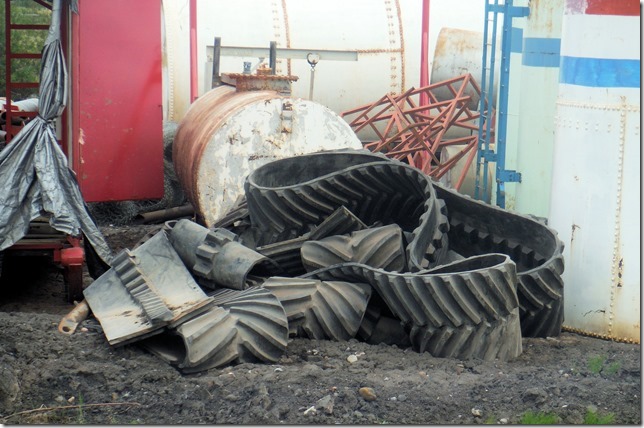
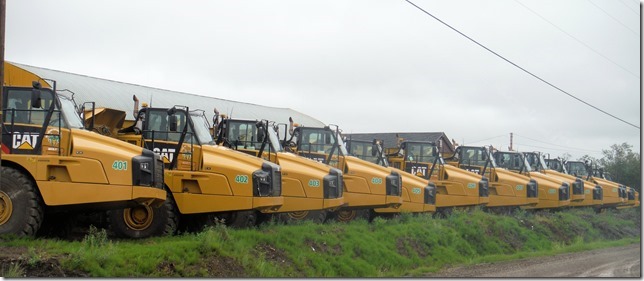
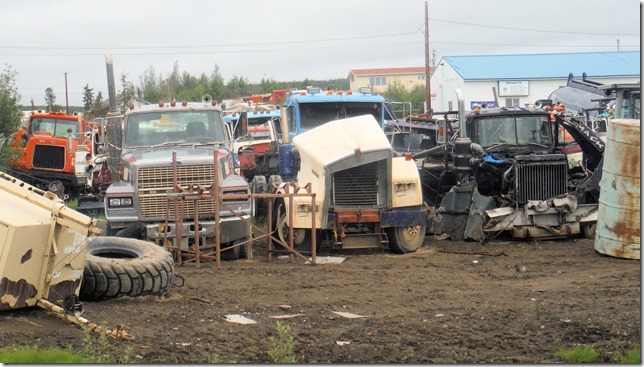
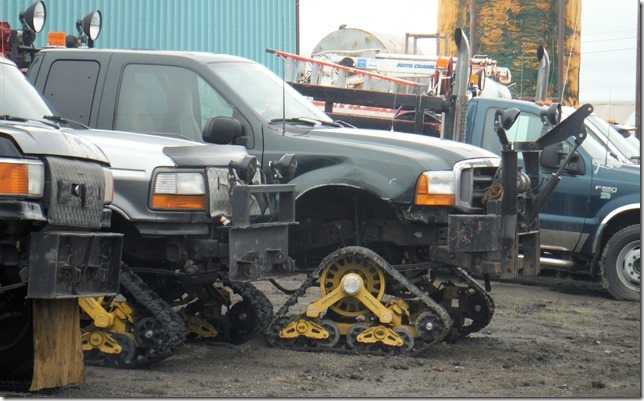
Their headquarters building has this incredible engine-crankshaft out front, about 14 feet long and stood on end. I have no idea what it goes to… something really big though.
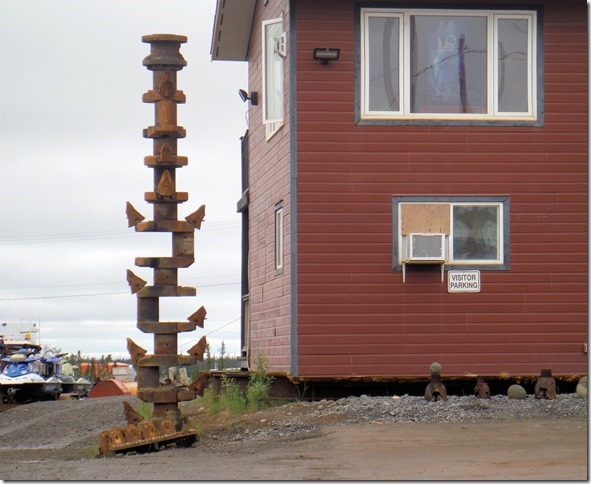
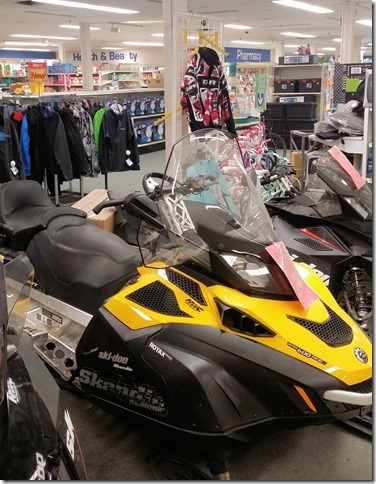 In town, the general store is really general. Snowmobiles up front, backed by men’s clothing, just in front of the laundry detergent, before you get to the Health and Bea_ty section next to the Pharmacy. Just out of sight you can find some new-in-the-box outboard boat engines.
In town, the general store is really general. Snowmobiles up front, backed by men’s clothing, just in front of the laundry detergent, before you get to the Health and Bea_ty section next to the Pharmacy. Just out of sight you can find some new-in-the-box outboard boat engines.
And what Arctic general store would consider itself complete without an assortment of tanned leathers and furs for your mitten or mukluk project?
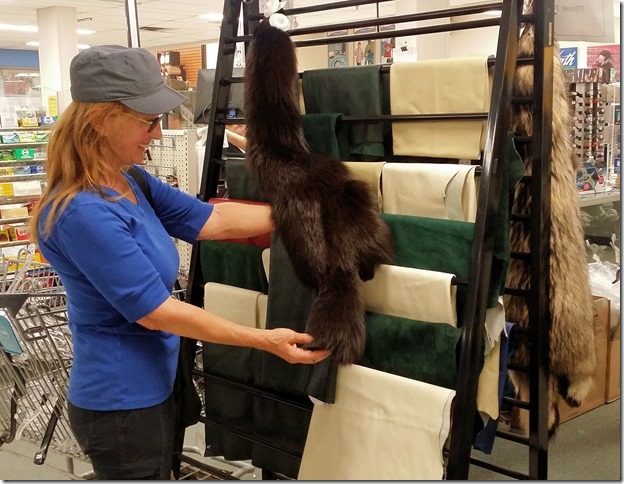
Perhaps the most significant, and deserved, icon of Inuvit is the Catholic church. It was conceived and built in the general shape of an igloo, driven from concept to completion by two dedicated members of the Oblate order. Its name is the same as the cathedral of Notre Dame: Our Lady of Victory.
Completed in 1960, the church was built during the same time when the actual town was being constructed. Town-building and road-building had all the priorities – so there were few materials available and almost no equipment for church-building. Building on pilings as per the rest of the town was simply not going to happen, and the two innovative Catholics conceived and created a totally unique design. The church is constructed of a dome-within-a-dome. This allows the outer structure to be set upon the permafrost, while the inner structure is thermally isolated, such that no undesirable melting occurs.
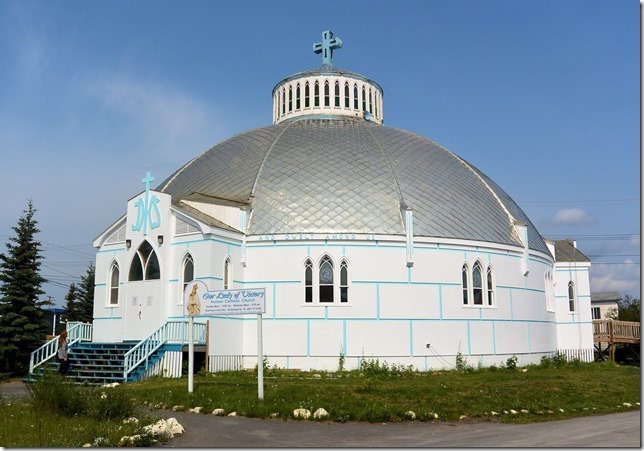
The architects took some pains to add various esthetics to the church, a rarity in a world where basic functionality is sometimes difficult to accomplish. Look at the arched entry steps, for example. The wood has to be wetted and clamped for days to be bent into the correct curves. You can see the repair work under way, with clamps forming the new wood.
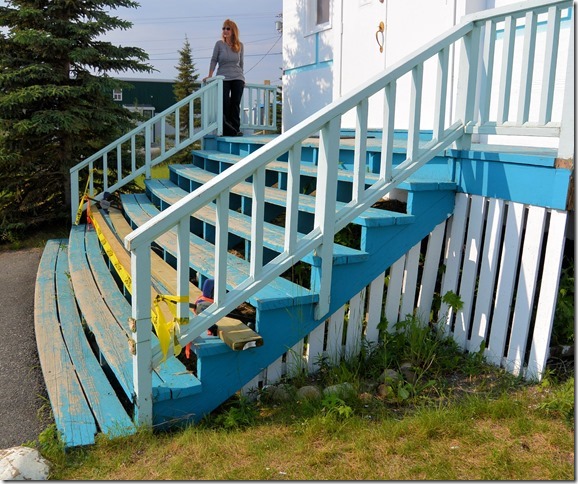
The inside of the church is another study in loving beauty, and you have to admire the Oblates for their determinism and ingenuity, especially in the face of their construction logistics challenges. Used hockey sticks were some of the extemporaneous materials brought to bear in the project.
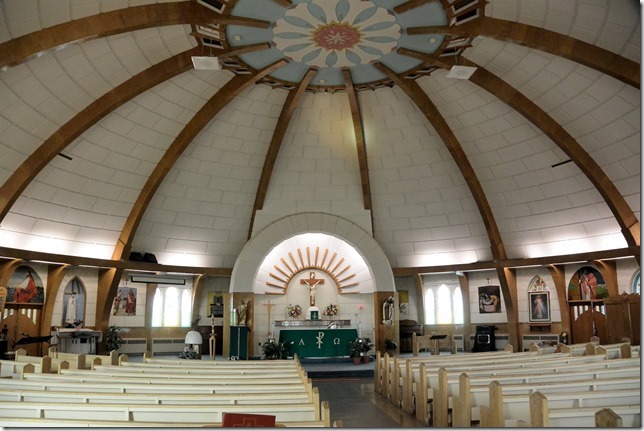
You’d think that sitting in the middle of a vast forest would provide a wealth of building materials, but it’s actually quite the opposite. The “forest” around Inuvik, for many many miles, consists only of the meanest, scrawny spruce trees. They are scarcely 30 feet tall and six inches in diameter – useless for real building lumber. In fact, the lumber to build the church came from 1,000 miles south in Fort Smith.
Almost forgot: did you ever wonder what folks in the Arctic do for vegetables in the all-dark winter? Well, no different than the rest of us – – they go to the store. But it’s expensive with a capital E. So some of the residents in Inuvik like to “grow their own”. And there’s a fabulous community garden, built in the former ice-hockey arena, with 75 5×10 plots for everything from flowers to cabbages. No, they can’t grow in the winter — but with 24-hour daylight, they can grow 3-5 crops in the summer and stock up for the long cold days to come.
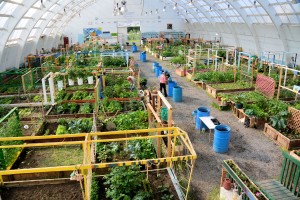
Tomorrow (30 June) is our trip to Tuktoyaktuk (“Tuck”) and the Arctic Ocean. We are pumped.

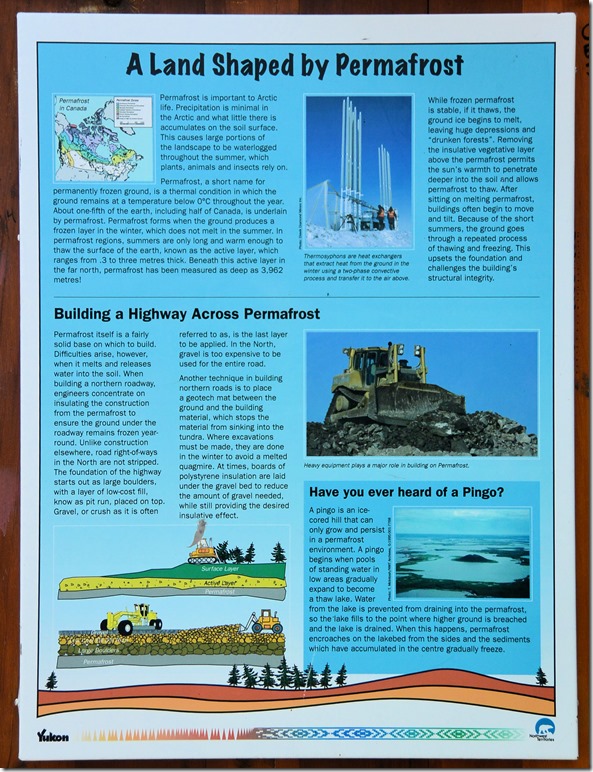
Hi Both of You…..Everything’s quite remarkable, and the Church is really beautiful; quite different and apart from most Catholicchurches.. Love, Mom
This was fascinating. I’ve forwarded it on to Dick so he can read about all of the road building and permafrost information. One question, were you able to attend Mass at the church? If so, would you write a little about it. It would be so interesting to note any differences in such a remote area compared to California. Thanks for all of the great posts.
Ann, Karin went to Mass and found it to be pretty normal, even with a Nigerian priest in residence. I guess there’s a level of standardization that prevails world-wide.
Another excellent, informative post. I would imagine the buildings must be heavily insulated on the bottom since they must be elevated and how much more energy it takes to heat them. Love the front wheel tracks on the pickups. Has anyone mentioned or have you seen evidence of the permafrost thawing due to rising temperatures? I’ve heard this, but that is possibly further north. Hardy folks up there!
Loved the hockey sticks in Church
Dennis, the local knowledge about some things is surprisingly scant. I’ve spoken to no-one who has any “global” level knowledge about such things. They do take a lot of pains to make sure that their constructions are not impacting it. But if temps really do warm, it’s not clear what happens to buildings and roads built on the frozen stuff. Deeper pilings and rock layers I suppose.